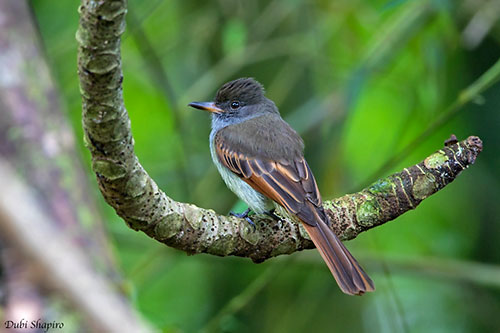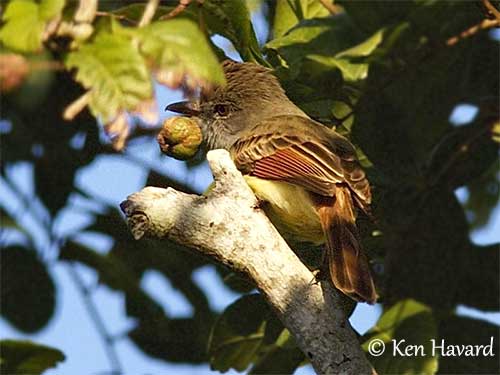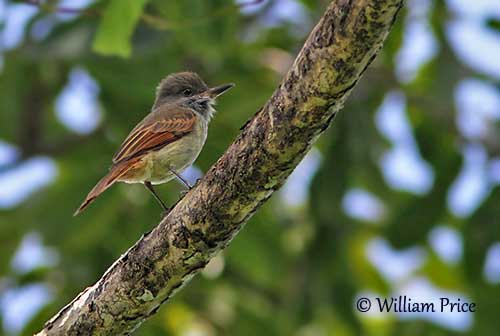
Fr: Tyran à queue rousse
Ang: Rufous-tailed Flycatcher
All: Rostschwanz-Schopftyrann
Esp: Copetón Colirrufo
Ita: Pigliamosche codarossiccia
Nd: Oranjestaarttiran
Sd: rödstjärtad topptyrann
Photographers:
Ken Havard
My Bird Gallery & Flickr gallery 1 & Flickr gallery 2
William Price
PBase-tereksandpiper & Flickr William Price
Dubi Shapiro
Dubi Shapiro Photo Galleries
Text by Nicole Bouglouan
Sources:
HANDBOOK OF THE BIRDS OF THE WORLD Vol 9 - by Josep del Hoyo - Andrew Elliot - David Christie - Lynx Edicions - ISBN: 8487334695
BIRDS OF THE WEST INDIES – by Herbert Raffaele, Kristin Williams et Tracy Pedersen – Helm – ISBN: 9780713649055
Avibase (Denis Lepage)
Neotropical Birds – Cornell Lab of Ornithology
Rufous-tailed Flycatcher
Myiarchus validus
Passeriformes Order – Tyrannidae Family
INTRODUCTION:
The Rufous-tailed Flycatcher is endemic to Jamaica where it is fairly common at mid-elevations in a variety of wooded habitats. It feeds typically on insects and fruits, and builds its nest inside a natural cavity.
The Rufous-tailed Flycatcher has restricted range and is described as uncommon to fairly common. In spite of habitat destruction, the species is not globally threatened.
DESCRIPTION OF THE BIRD:
Biometrics:
Length: 24 cm
Weight: 38,5-43 g
The Rufous-tailed Flycatcher is fairly distinctive. It is a large Tyrannidae with rufous flight-feathers and tail, and pink base of the bill.
The upperparts are dull olive with tinged rufous uppertail-coverts. On the upperwing, primary and secondary feathers have rufous outer webs, but with broader rufous band on tertial’s outer webs. Greater and median wing-coverts show broad rufous tips. On the tail, all the rectrices are rufous and bordered by narrow dark brown band, except central pair which has paler outer webs.
On the underparts, throat and breast are dark grey whereas belly and undertail-coverts are yellow. A strong greyish wash on upper breast involves indistinct demarcation between breast and belly. Thighs are olive-brown. Underwing-coverts are rufous.

On the head, the crown is greyish-brown. Face and lores are slate grey.
The bill is black with pink base of lower mandible. The mouth is bright orange. The eyes are brown. Legs and feet are blackish.
Male and female are similar.
The juvenile has whitish underparts.
RANGE:
The Rufous-tailed Flycatcher is found only in Jamaica.
HABITAT:
The Rufous-tailed Flycatcher frequents a variety of wooded habitats but mainly humid forests, and less often dry scrub and secondary growths.
It is mainly visible at mid-elevations, from 300 to 2,000 metres, and less frequently at high elevations and in lowlands.
CALLS AND SONGS: SOUNDS BY XENO-CANTO
The Rufous-tailed Flycatcher is more often heard than seen, and detected especially by its loud, raucous vocalizations.
It gives a fast, descending “pree-ee-ee-ee-ee” very similar to the neighing of a horse. This call is used in territorial defence.
We can also hear a disyllabic “wick-up” and “chi-chi-chiup” notes.

BEHAVIOUR IN THE WILD:
The Rufous-tailed Flycatcher feeds on insects and fruits. Insect diet includes cicadas, moths and butterflies.
It typically hunts by sallying from perch among the thick vegetation beneath the canopy.
The flycatchers of genus Myiarchus build the nest inside a natural cavity.
The Rufous-tailed Flycatcher is probably sedentary.
The flight of Tyrannidae is usually easy and agile.
REPRODUCTION OF THIS SPECIES:
The breeding season takes place from April to July.
The Rufous-tailed Flycatcher builds its nest inside a natural cavity or in stump of tree. The nest is made with grass and leaves, but no reports of snake skin, often used as lining by Myiarchus flycatchers.
The female lays 3-5 creamy-white eggs with dark markings at the broad end.
PROTECTION / THREATS / STATUS:
The Rufous-tailed Flycatcher has restricted range in which it is described as uncommon to fairly common.
This species is vulnerable to degradation and destruction of the habitat, due to clearance of second growth for coffee and pine (Pinus) plantations, use of pesticides and conversion for farming and human settlements.
The population is suspected to be declining, but the Rufous-tailed Flycatcher is not globally threatened and currently evaluated as Least Concern.
